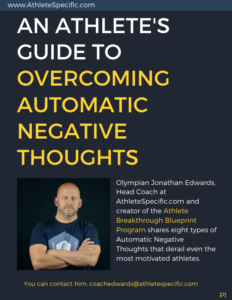“The greatest athletes and artists are their worst critics. The trick is being your worst critic while not driving yourself crazy.”
Mat Hoffman – American BMX Rider
As athletes we are our own best Head Coach. The problem is…our Coach can be a major a..hole.
It’s true.
The coach in our head is the coach we can’t get away from. It’s like he’s sitting on your shoulder, or your lap…all…the…time.
The athlete thinks, “Hey that went pretty good!”
But that inner coach can come back with, “Yeah, but…”
The “Yeah, but’s…” can get you.
They can be relentless. An endless stream of “but’s”. Literally. Butts.
They stink too.
Because we have this thing in our brain called a Prefrontal Cortex, our brain can make events from our past, or events from our future, feel like they are happening right now.
The funny thing about that is that research has shown that when we think of things in our past we only truly really remember about half of it.
The other half we make up.
Those events in the future? Well, we make that up too. We are fortune-telling as we imagine just how bad things are going to go. (I say bad because it’s a rare skill to think of all the good that will happen).
As athlete’s we can really beat ourselves up about what is going to happen in the future. I call it “disasterizing”.
But there is an approach that can really help an athlete in sport and life successfully navigate those future events…it’s called Self-Distancing and there’s some really cool research about it.
The idea of Self-Distancing is based on looking at yourself as a third party. Not you looking at you but like someone outside of yourself is looking at you.
When we look at a situation as our self our prefrontal cortex treats it like it’s happening now. Our brain relives those moments whether real or imagined.
And because of that, the emotional triggers we feel can affect how we think about the situation. If you imagine yourself falling in the future it can feel like it’s happening right now.
But by looking at yourself in the third-person you can take the emotion out of it and look at a situation more clearly.
I call this the “homeless guy” technique. Let me explain.
Odds are your soul isn’t completely dark. When you see someone homeless on the street your mind doesn’t totally jump to, “That lazy, good-for-nothing, jerk. Get a job!”
I doubt that’s you.
Your mind may think, “Why doesn’t that guy get a job?” but you can probably quickly and easily turn it to a thought like, “I wonder what happened? How did he get there? He probably just needs a little bit of help to get back on his feet.”
Any number of thoughts can go through your mind on this, but the key emotions I want to point out are sympathy and empathy.
Sympathy and Empathy: For Yourself
When we look from a third-party point of view it is usually easier to take a position of sympathy and/or empathy than if we are in the situation ourselves.
When you are sympathetic to another person you are putting yourself in their shoes and acknowledging the struggle they are going through.
When you are empathetic to another person you are actually acknowledging their struggles because you’ve had a similar experience.
But because there is distance between you and the person you are observing, the emotional connection isn’t so strong. There can still be some emotions but they are typically less and you can view the situation a little more clearly instead of being engulfed in a haze of emotions.
Granted…this can take a bit of skill, but as you get better at this approach you can look at your progress, or lack thereof, strategically.
Build Your Athlete-Bot: Your Learning Machine
Another approach I like to use with my athletes in sports and life is to view themselves as a robot. Robots…so far…don’t have emotions. If something works..great. If something doesn’t work…it’s no big deal. It’s just learning.
Every situation you encounter is really just an opportunity to learn. Instead of beating yourself up about something you’ve done, or disasterize what could happen in the future, you can view all of these opportunities as opportunities to learn.
Things either work…or they don’t.
When they don’t, you reprogram that robot to have a better chance of succeeding in the future.
Emotions Aren’t Bad. But They Can Be Limiting
Listen, as much as it would be great to eliminate emotions all together, like a robot, that’s unrealistic when it comes to humans.
Emotions are a chemical response to an experience. And our brain can relive that experience over and over and over again, if we let it.
The goal then is to not eliminate emotions all together but to limit our regurgitation of the same negative emotions again and again.
Ever been around an athlete in sports or life who is stuck in a mood? That mood is a recycling of past experiences. They are stuck in the emotions of a past event. Relive that over and over again and the are stuck in a mood.
Or take that same athlete and have them disasterize what might happen in the future and they will also get stuck in a mood. It’s an endless loop that needs to be broken and that’s how self-distancing can help, but eliminating (or at least reducing) the emotions someone feels about an even whether it’s in the past or in the future.
Recap
Take a moment to think about how self-distancing can help you remove the emotion as you review past results or look forward to events in the future.
By taking a more empathetic or sympathetic approach to your results you will reduce some of the stress you may be feeling. By taking it easy and looking at yourself as someone else you reduce the powerful emotions that might make you angry, sad, or otherwise not very happy about life.
Being an athlete in sport and life is all about wiring in new neural connections. We have a better chance of doing that effectively when we remove the emotion of a situation.
Just like the wiring and rewiring of a robot, bad results aren’t necessarily ‘bad’. It’s just learning. And re-learning. There are no emotions tied to the wires in a robot.
It is rare to doubt the work ethic of a committed athlete. By reducing the emotions we can get better results.

